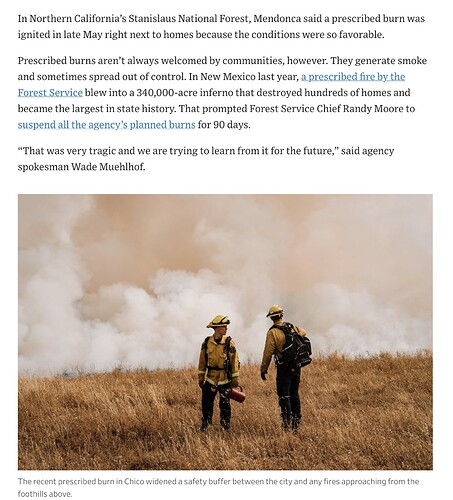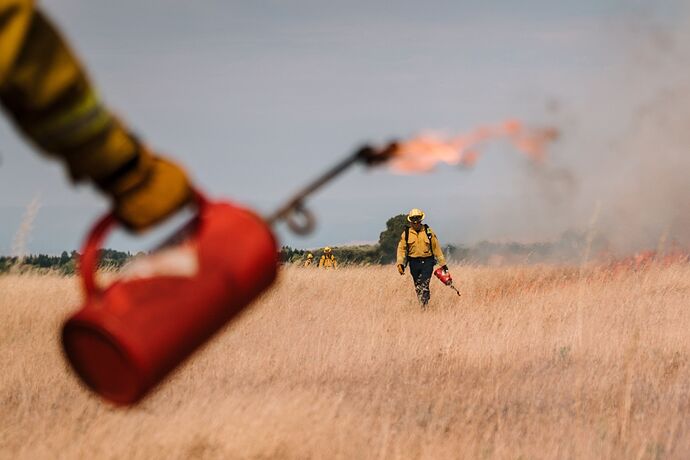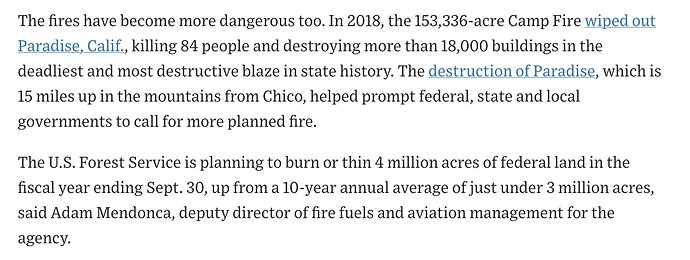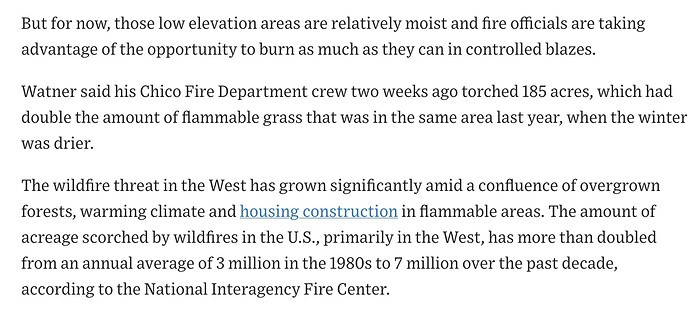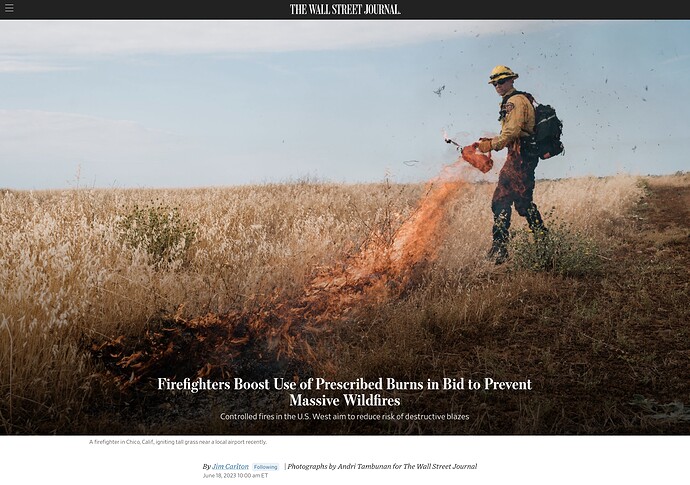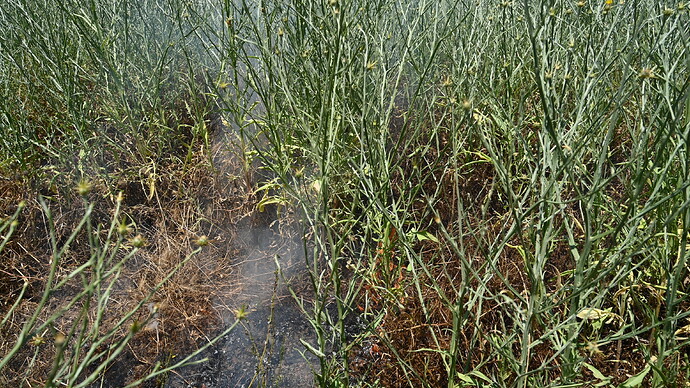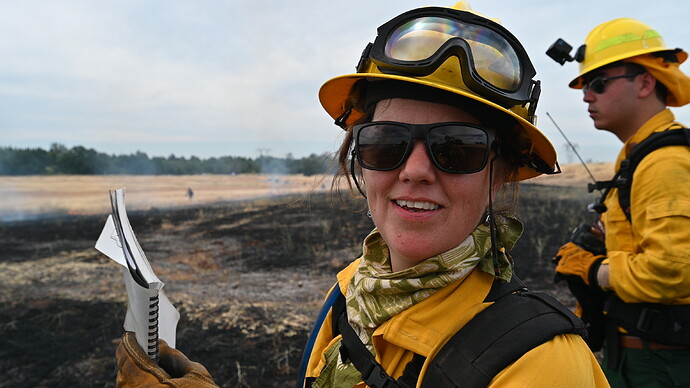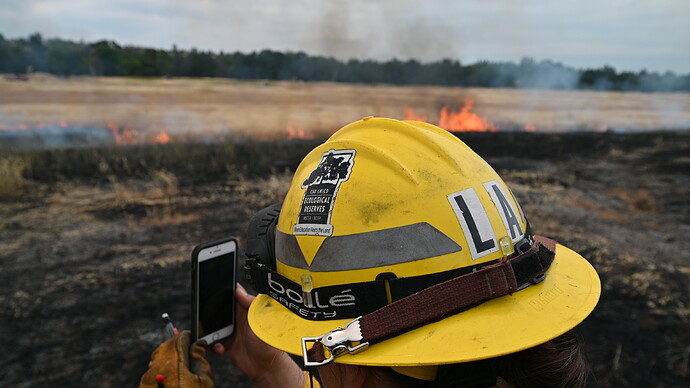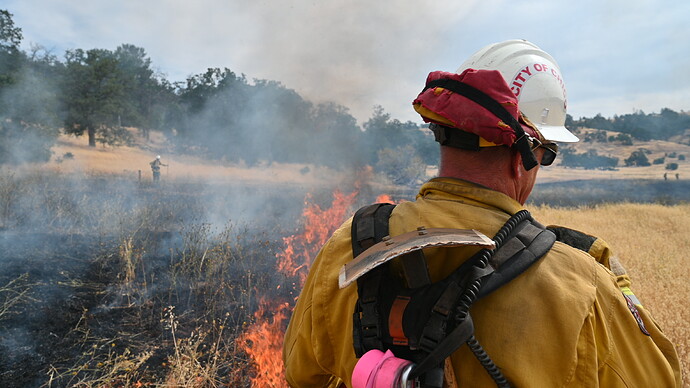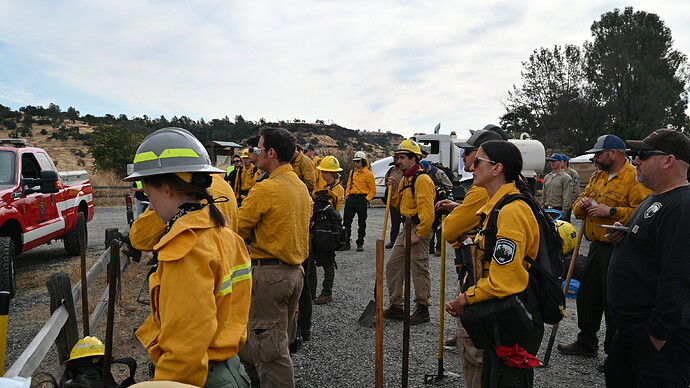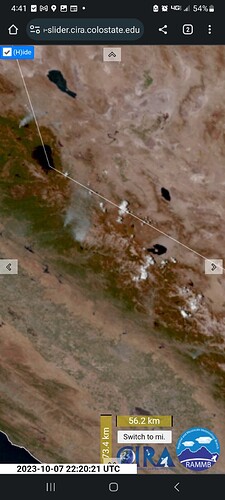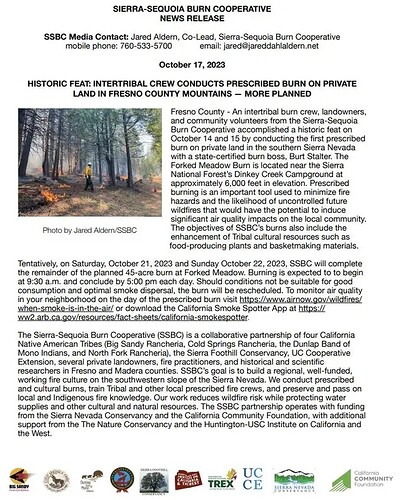The Wall Street Journal sent a photographer and reporter out to a burn Chico FD did earlier this month at the Chico Airport. Their article - about how firefighters are taking advantage of a mild spring to do more RX fire - came out this morning.
Burned about 120 acres of grass and star thistle with Chico FD and many cooperators in Bidwell Park this week. This project put black on the ground at the mouth of Big Chico Creek Canyon in an area that has strong downslope night winds and a history of fires pushing toward the City of Chico at night.
Objectives were to create black at edge of City, kill yellow star thistle, and train.
The event was open to red-carded volunteers, and run in cooperation with the 2022-23 Plumas TREX Prescribed Fire Training Exchange. The event was run by a Chico Fire IC (Deputy Chief) and 2 Chico FD firing bosses. Other participants included Butte County RCD, CSU, Chico Ecological Reserves, Plumas Underburn Cooperative, Butte PBA, Watershed Center, CCC, Chico Parks Dept, PG&E, Defensible Space Solutions (DSS), Deer Creek Resources, Terra Fuego Resource Foundation, and others.
One unique thing about this event was that Chico FD ran the incident with 2 Divisions, with one of these staffed with a majority of non-FD personnel. This wouldn’t have happened 2 years ago. Local cooperators like the Chico State Reserves and RCD are getting their people a lot of torch time - some of the students and Reserve employees have gotten over 30 burn days in the past year in a wide variety of fuel types, and have been building a lot of trust with the agencies.
Though Cal Fire was not on site, they indirectly support this work with a lot of funding through their workforce development grants. The Hayfork Watershed Center sent a Type VI engine and 2 instructors under their ‘All Hands All Lands’ CF funding, and many of the Chico State Students and Reserve staff, Plumas Underburn Cooperative and Firesafe Council staff, myself and other contractors are being paid out of similar grants.
We’ve been training Fire Effects Monitors (FEMOs), taking videos and field observations, and mapping star thistle pre-burn to try to dial in better prescriptions for star thistle control. This is the second burn on this site in 3 years. We had plenty of cured grass to carry the fire through the thistle (still fairly green), and think we met our YST objectives in most areas.
We had mixed results burning star thistle a couple week ago at the Chico Airport. In areas of sparse star thistle with a good (dried) grass crop, the thistle was killed, but in pure stands of YST that weren’t cured, there wasn’t enough dry fuel to carry fire very well without good wind. If we want to control heavy infestations of thistle, we need to be burn later in the summer. Fall burning isn’t ideal because it drops all of its seed by then… I’m hoping the relationships and trust we’re building here will make it easier for us to take on some in-season burns in appropriate areas moving forward.
Here are some videos of firing ops.
https://twitter.com/wildland_zko/status/1672803980769103872?s=20
Cal Fire SHU did a VMP prescribed burn today at Ross Ranch, near Shasta College, and LNU supported Fire Forward in a burn near Sears Point Raceway, yesterday. Anyone else working on in-season burns in California?
https://twitter.com/CALFIRESHU/status/1682050783473467393?s=20
SCU burned some acreage at Grant Ranch in Santa Clara County last week. Target was close to 300ac but not sure what they actually got up to. CZU has done a few small ones in the SFPUC watershed and at Filoli Preserve in Woodside.
Prescribed fire along side wildland use fire.
North to South:
Sagehen RX
North Beardsley RX
Quarry WFU
Big stump RX
Rabbit WFU.
So I work for the forest service and I am also apart of my counties local PBA, but what is a good route to get more involved in prescribed and management fires? what are the short and long term goals to do so?
If I was outside looking in, I’d probably get a hold of Pyrogeograghy on this site.
Go talk to your fuels staff?
thank you I will try doing that when I go back to my engine towards the very end of the season currently away on an interagency engine.
thank you!
+1 to what @halley8 said.
Here is an interview I did with Wolfy Rougle, founder of our local prescribed burn association in Butte County.
I like Wolfy’s vision of helping folks in the foothills get more comfortable with fire, and the idea of getting people interested again in woodsy activities like cutting firewood and burning piles:
“We don’t have burns during the summertime or in the declared fire season when the weather is dry. When we can have prescribed burns has to do with the weather and the fuel—grass or brush—moistures. It’s not always by calendar, but generally speaking, from fall through late spring, these burns can occur,” said Gregg Bratcher, the deputy chief of prescribed fire and environmental protection at the Cal Fire…
… The (UCLA) study predicts that by 2060, the number of RxDays, or days favorable for prescribed fire, will significantly decrease by around 10 days per year across the West Coast. Projected decreases are most significant in the Pacific Southwest—reaching 16.6 fewer days yearly.
Such weather changes have already impacted Cal Fire’s ability to burn.
“This year was an anomaly. We had a very wet season that lasted well into June. These wet seasons need a drying period with sunshine to dry out the fuels, so we may have fewer days to burn, as we have this year,” Bratcher said.
I feel like this article has some issues. Many Cal Fire units got prescribed burning done this year during what is often considered to be ‘fire season’, and we have the means to burn many fuel types ‘in season’ when resources are available in slow years like this one. The burn window above 4,000’ this year in the Sierra/Cascade barely closed between June and now, as evidenced by the lack of rapid growth on the many lightning ignitions we had in the Northern Sierra in August, and the ability of the STF to manage several fires straight thru the summer.
The conditions of this year aren’t an example of climate change shortening burn windows, unless you consider days which were too WET to burn, not too dry.
The UCLA study was based on only 24 historic burn plans. Just because many agency burners over the past 2 decades have been conservative in their prescriptions doesn’t mean these parameters should be considered the gospel of responsible burning. We have safely burned grass at the Chico Airport with the City of Chico on breezy 90 degree+ days when the probability of ignition was 100%, and I’ve been on safe burns in the Great Plains that got lit under 30 mph+ winds.
We’ve got to be open to burning under hotter prescriptions if we hope to actually burn things intensely enough to actually reduce fuels. We won’t achieve meaningful reductions of large fire potential in the brush and timber fuel types with a bunch of low-intensity pine needle and oak litter burns. We can mitigate a lot of the hazards of burning under more severe conditions by designing units which are surrounded by reduced fuels or black from recent wildfires, large grazed areas, or other burns or blacklines done earlier in the season under milder conditions.

